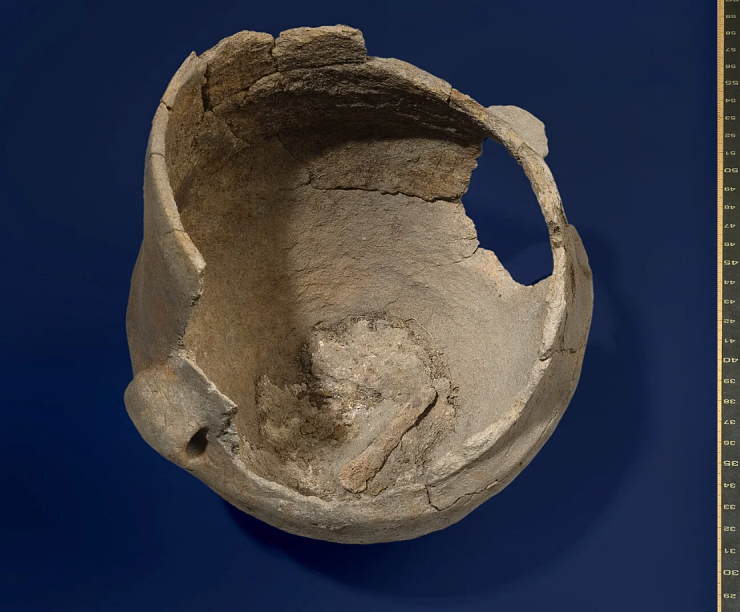Otázkou je, jestli tady za 5000 let vůbec někdo bude. Zatim to tak nevypadá.....🤘🏻
Food remains in ceramic pots what did they eat in northern and central Europe 5,000 years ago?
Categories: Nálezy nejenom s detektorem ve Skandinávii , Nálezy nejenom s detektorem v západní Evropě
Researchers from Kiel University have demonstrated in the first archaeobotanical study of burnt food remains on the surface of ceramicpottery on the surface of ceramic vessels to show how varied and tasty the food prepared in East Holstein was 5,000 years ago.
The analysed ceramic vessels come from one of the oldest villages in Schleswig-Holstein - the Neolithic settlement Oldenburg LA 77 in Ostholstein. The study published in PLOS ONE shows that both cereals and wild plants played a major role in the diet. Using scanning electron microscopy SEM and chemical analysis, the sophisticated preparation of different plant foods was identified.
The burnt food contained the remains of two-grain wheat, barley and white merlin, a wild plant that grows as a weed and whose seeds contain high amounts of starch. "The charred grains and chaff from wheat and barley, as well as the seeds of merlin, have already been documented by archaeobotanical analyses of soil samples from this Neolithic settlement," described team member Dr Dragana Filipović.
Cereals had an important position in the diet, and wild plants enriched the food spectrum of the first farmers in the north. Barley was harvested at milk maturity and prepared in a similar way to the green spelt traditionally produced in Baden-Württemberg. The wheat was processed in its sprouted state, which gave the porridge a sweet taste. Food in the Neolithic was therefore not bland but rather varied. People attached great importance to good taste.
Chemical analyses of the pottery have so far shown that the vessels contained dairy products. Cereals and dairy products were probably made into porridge for everyday use in the same vessels and formed a balanced dietary basis. Ceramic vessels were thus used almost exclusively for processing or cooking cereal grains
"While animal fats tend to be absorbed into the (porous) pottery and leave clearly identifiable traces, plant food components can only be detected in the burnt crust," explained Dr. Lucy Kubiak-Martens, cooperation partner at BIAX Consult and first author of the study.
It shows how important a multi-method approach is for reconstructing Neolithic recipes from different ingredients. The discovery expands the understanding of the complex process of converting plants into food in the period just after the introduction of agricultural lifestyles and cultivated plants in northern and central Europe.
Roman Nemec
Sources: phys.org, academia.edu, journals.plos.org

A 5,000-year-old funnel cup with a burnt food crust from the Neolithic settlement of Oldenburg
 a detailu připáleniny s nezralými zrny ječmene (o velikosti cca 4 mm x 1,4–1,8 mm) v matrici..png)
Microscopic image of a food scorch (left) and detail of a scorch with immature barley grains (ca. 4 mm x 1.4-1.8 mm) in the matrix

examples of thick-walled, undecorated ceramic sherds from Oldenburg

images here with fragments of white Merlin seeds embedded in the residue matrix
 a vnitřní povrch se spečenými zbytky (vpravo nahoře) a také detail odebraného zbytku (dole). bílé obdélníky označují vzorkované místo.png)
sherd old 15 underside with fire marks (top left) and inner surface with sealed residue (top right), as well as a detail of the removed residue (bottom). The white rectangles indicate the sampled area
 a vnitřní povrch se spečenými zbytky (vpravo nahoře) a také detail odebraného zbytku (dole). bílé obdélníky označují vzorkované místo.png)
shard old 08 underside with traces of fire (top left) and inner surface with sealed residues (top right) and also detail of the removed residue (bottom).

reconstruction of the Neolithic settlement of Oldenburg

excavations at the Oldenburg settlement site
The article is included in categories:




